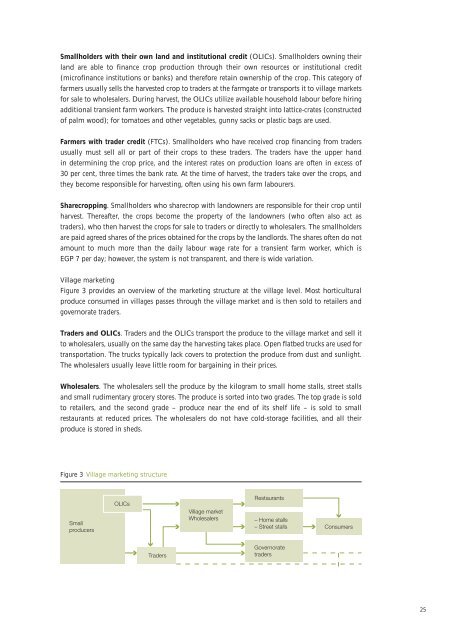Egypt: Smallholder contract farming for high-value and ... - IFAD
Egypt: Smallholder contract farming for high-value and ... - IFAD
Egypt: Smallholder contract farming for high-value and ... - IFAD
You also want an ePaper? Increase the reach of your titles
YUMPU automatically turns print PDFs into web optimized ePapers that Google loves.
<strong>Smallholder</strong>s with their own l<strong>and</strong> <strong>and</strong> institutional credit (OLICs). <strong>Smallholder</strong>s owning their<br />
l<strong>and</strong> are able to finance crop production through their own resources or institutional credit<br />
(microfinance institutions or banks) <strong>and</strong> there<strong>for</strong>e retain ownership of the crop. This category of<br />
farmers usually sells the harvested crop to traders at the farmgate or transports it to village markets<br />
<strong>for</strong> sale to wholesalers. During harvest, the OLICs utilize available household labour be<strong>for</strong>e hiring<br />
additional transient farm workers. The produce is harvested straight into lattice-crates (constructed<br />
of palm wood); <strong>for</strong> tomatoes <strong>and</strong> other vegetables, gunny sacks or plastic bags are used.<br />
Farmers with trader credit (FTCs). <strong>Smallholder</strong>s who have received crop financing from traders<br />
usually must sell all or part of their crops to these traders. The traders have the upper h<strong>and</strong><br />
in determining the crop price, <strong>and</strong> the interest rates on production loans are often in excess of<br />
30 per cent, three times the bank rate. At the time of harvest, the traders take over the crops, <strong>and</strong><br />
they become responsible <strong>for</strong> harvesting, often using his own farm labourers.<br />
Sharecropping. <strong>Smallholder</strong>s who sharecrop with l<strong>and</strong>owners are responsible <strong>for</strong> their crop until<br />
harvest. Thereafter, the crops become the property of the l<strong>and</strong>owners (who often also act as<br />
traders), who then harvest the crops <strong>for</strong> sale to traders or directly to wholesalers. The smallholders<br />
are paid agreed shares of the prices obtained <strong>for</strong> the crops by the l<strong>and</strong>lords. The shares often do not<br />
amount to much more than the daily labour wage rate <strong>for</strong> a transient farm worker, which is<br />
EGP 7 per day; however, the system is not transparent, <strong>and</strong> there is wide variation.<br />
Village marketing<br />
Figure 3 provides an overview of the marketing structure at the village level. Most horticultural<br />
produce consumed in villages passes through the village market <strong>and</strong> is then sold to retailers <strong>and</strong><br />
governorate traders.<br />
Traders <strong>and</strong> OLICs. Traders <strong>and</strong> the OLICs transport the produce to the village market <strong>and</strong> sell it<br />
to wholesalers, usually on the same day the harvesting takes place. Open flatbed trucks are used <strong>for</strong><br />
transportation. The trucks typically lack covers to protection the produce from dust <strong>and</strong> sunlight.<br />
The wholesalers usually leave little room <strong>for</strong> bargaining in their prices.<br />
Wholesalers. The wholesalers sell the produce by the kilogram to small home stalls, street stalls<br />
<strong>and</strong> small rudimentary grocery stores. The produce is sorted into two grades. The top grade is sold<br />
to retailers, <strong>and</strong> the second grade – produce near the end of its shelf life – is sold to small<br />
restaurants at reduced prices. The wholesalers do not have cold-storage facilities, <strong>and</strong> all their<br />
produce is stored in sheds.<br />
Figure 3 Village marketing structure<br />
Small<br />
producers<br />
OLICs<br />
Village market<br />
Wholesalers<br />
Restaurants<br />
– Home stalls<br />
– Street stalls<br />
Consumers<br />
Traders<br />
Governorate<br />
traders<br />
25

















